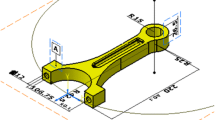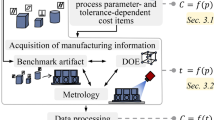Abstract
Process planers typically utilize different datum features than designers use when specifying tolerances. Datum features used in process plans are chosen to simplify setups and achieve desired geometric accuracy. Meanwhile, proper machining tolerances are required to be reassigned to satisfy design requirements. However, existing methods to transfer geometric tolerances directly and accurately are still missing due to incompatible mathematical models of tolerances. Also, the affection of material conditions on datum and partial constraint situations have not been deeply considered yet. Since cylindrical features are often used as datum features, this paper describes the use of tolerance maps (T-Maps) (patent no. 6963824) and manufacturing maps (M-maps) to establish analytical relationship among all relevant design and machining tolerances for transfer of cylindrical datum. Firstly, a parametric model of datum transfer is proposed to describe factors involving the process. Next, based on spatial and geometric parameters, as well as tolerances information, variation analysis among features is implemented to formulate transformed T-Maps, sum of which constructs M-Map. Then, distinct bounding boxes of cross-sections in M-Map are extracted through computing vertex coordinates of their boundaries due to complete and partial constraint scenarios. Thereafter, by virtue of bounding boxes, relationship among design and machining tolerances are obtained through fitting M-Maps into T-Maps. Finally, an example is introduced to verify feasibility of the proposed model and method.
Similar content being viewed by others
References
Desrochers A, Clément A (1994) A dimensioning and tolerancing assistance model for CAD/CAM systems. Int J Adv Manuf Tech 9(6):352–361
Shah JJ, Zhang BC (1992) Attributed graph model for geometric tolerancing. In: 18th Annual ASME Design Automation Conference. pp 133–140
Tsai JC, Cutkosky MR (1997) Representation and reasoning of geometric tolerances in design. AI EDAM 11(4):325–342
Shen Z, Shah JJ, Davidson JK (2008) Analysis neutral data structure for GD&T. J Intell Manuf 19(4):455–472
Zhang K, Li Y, Tang S (2010) An integrated modeling method of unified tolerance representation for mechanical product. Int J Adv Manuf Tech 46(1–4):217–226
Tang XQ, Davies BJ (1988) Computer aided dimensional planning. Int J Prod Res 26(2):283–297
Ji P, Fuh JYH, Ahluwalia RS (1996) A digraphic approach for dimensional chain identification in design and manufacturing. J Manuf Sci E-T Asme 118(4):539–544
Desrochers A (2003) A CAD/CAM representation model applied to tolerance transfer methods. J Mech Design 125(1):14–22
Chase KW, Gao J, Magleby SP (1995) General 2-D tolerance analysis of mechanical assemblies with small kinematic adjustments. J Des Manuf 5:263–274
Glancy CG (1994) A second-order method for assembly tolerance analysis. Brigham Young University, Dissertation
Gao J, Chase KW, Magleby SP (1998) Generalized 3-D tolerance analysis of mechanical assemblies with small kinematic adjustments. IIE Trans 30(4):367–377
Bourdet P, Clement AA (1988) Study of optimal-criteria identification based on the small displacement screw model. CIRP Annals- Manuf Tech 37(1):503–506
Giordano M, Pairel E, Samper S (1999) Mathematical representation of tolerance zones. In: Houten FV, Kals H (eds) Global Consistency of Tolerances. Springer, Netherlands, pp 177–186
Zou Z, Morse EP (2003) Applications of the GapSpace model for multidimensional mechanical assemblies. J Comput Inf Sci Eng 3(1):22–30
Davidson JK, Mujezinovic A, Shah JJ (2002) A new mathematical model for geometric tolerances as applied to round faces. J Mech Des 124(4):609–622
Bhide S, Ameta G, Davidson JK, Shah JJ (2007) Tolerance-maps applied to the straightness and orientation of an axis. In: Davidson JK (ed) Models for Computer Aided Tolerancing in Design and Manufacturing. Springer, Netherlands, pp 45–54
Ameta G, Davidson JK, Shah JJ (2007) Using tolerance-maps to generate frequency distributions of clearance and allocate tolerances for Pin-Hole assemblies. J Comput Inf Sci Eng 7(4):347–359
Zhang G (1996) Simultaneous tolerancing for design and manufacturing. Int J Prod Res 34(12):3361–3382
Thimm G, Lin J (2005) Redimensioning parts for manufacturability: a design rewriting system. Int J Adv Manuf Tech 26(4):399–404
Jaballi K, Bellacicco A, Louati J, Rivière A, Haddar M (2009) Dimensioning of the intermediate states of the machined phases “DISMP” approach. Int J Adv Manuf Tech 45(9–10):907–921
Louati J, Ayadi B, Bouaziz Z, Haddar M (2006) Three-dimensional modeling of geometric defaults to optimize a manufactured part setting. Int J Adv Manuf Tech 29(3–4):342–348
Anselmetti B (2012) ISO manufacturing tolerancing: three-dimensional transfer with analysis line method. Int J Adv Manuf Tech 61(9–12):1085–1099
Caux M, Anselmetti B (2012) 3D ISO manufacturing specifications with vectorial representation of tolerance zones. Int J Adv Manuf Tech 60(5–8):577–588
Haghighi P, Vemulapalli P, Mohan P (2013) Preliminary investigation on generating an explicit GD& T scheme from a process plane. In: Proceeding of ASME 2013 IDETC, Portland, USA
Zhou S, Huang Q, Shi J (2003) State space modeling of dimensional variation propagation in multistage machining process using differential motion vectors. IEEE Robot Autom Mag 19(2):296–309
Speckhart FH (1972) Calculation of tolerance based on a minimum cost approach. J Eng Ind-T ASME 94(2):447–453
Spotts MF (1973) Allocation of tolerances to minimize cost of assembly. J Eng Ind-T ASME 95(3):762–764
Author information
Authors and Affiliations
Corresponding author
Rights and permissions
About this article
Cite this article
Jiang, K., Davidson, J.K., Liu, J. et al. Using tolerance maps to validate machining tolerances for transfer of cylindrical datum in manufacturing process. Int J Adv Manuf Technol 73, 465–478 (2014). https://doi.org/10.1007/s00170-014-5792-9
Received:
Accepted:
Published:
Issue Date:
DOI: https://doi.org/10.1007/s00170-014-5792-9




